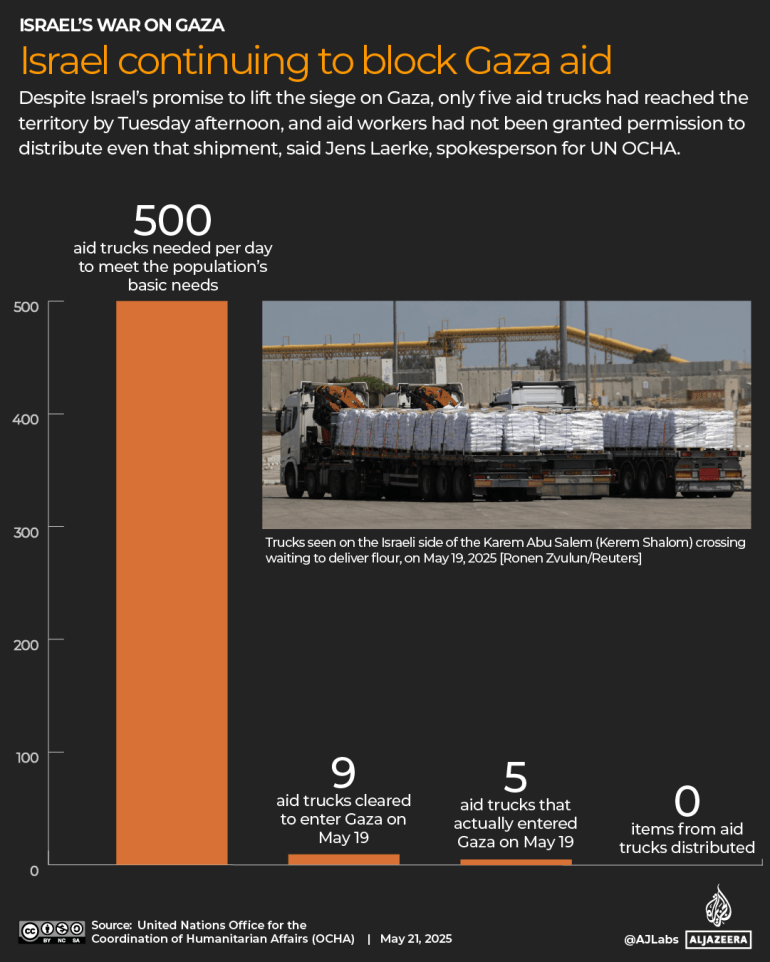Gaza’s population is on the verge of starvation and needs immediate assistance.
Only five aid trucks had actually entered Gaza as of Tuesday night, despite Israel’s official resignation and public declaration that it will now permit trucks to enter the country after a more than two-month blockade.
According to spokesperson for the UN Office for the Coordination of Humanitarian Affairs (OCHA), humanitarian workers have been prevented from dispensing the aid inside those trucks, even with those inside Gaza.
Up to 14 000 babies are at risk of passing away from malnutrition in the Gaza Strip, according to numerous aid organizations, with more than 2 million people living there before Israel’s war on Gaza. Israel’s ongoing occupation of the Strip continues despite the high cost to the international community. Even if Israel claims 93 trucks entered Gaza on Tuesday and that the aid was distributed, it still accounts for 20% of the territory’s daily pre-war needs.
How desperate is the humanitarian crisis in Gaza?
Numerous organizations have reported that Gaza’s situation is desperate after 11 weeks of a relentless siege.
One in five Palestinians, or 500,000 people, are living in poverty. According to the UN’s Integrated Food Security Phase Classification (IPC), the majority of the population has high levels of acute food insecurity.
A few trucks carrying delivery aid have since arrived in #Gaza, but according to @UNReliefChief, they are “a drop in the ocean of what’s needed.” https: //t. UN_Spokesperson briefing the press in a photo. twitter.com/fWzb7lg5U4
The IPC warned that an official famine could be declared as a direct result of Israeli action at any time between now and September, noting that “the risk of famine in the Gaza Strip is not just possible; it is increasingly likely.”
Officially, a famine occurs when at least 20% (one-fifth) of households are plagued by severe food shortages, more than 30% of children are in acute malnutrition, and at least two out of every 10,000 people or four out of every 10,000 children per day are starved or have been harmed by hunger-related causes.

More than just hunger, the term “famine” is used. It refers to one of the worst humanitarian crises ever, indicating that all available food, water, and other essential infrastructures are completely gone.
Since Israel’s complete blockade began on March 2, at least 57 children have died as a result of malnutrition, according to a report from the World Health Organization (WHO) last week.
How has the Israeli siege affected international relations?
MSF’s Pascale Coissard, the emergency coordinator for Doctors Without Borders in Gaza, described the humanitarian flow into Gaza as “ridiculously inadequate.” The organization claimed that Israel’s restriction on entering Gaza was “a smokescreen to pretend the siege is over.”
After months of an air-tight siege, the Israeli government’s decision to grant Gaza a ridiculously inadequate amount of aid indicates that they are trying to avoid the accusation of starving the people there while actually keeping them surviving, according to Coissard.

Israel is under intense international pressure to lift Gaza’s siege. The United Kingdom, France, and Canada have threatened sanctions if aid is not provided to those trapped in the enclave, while twenty-three countries, including many of Israel’s traditional allies, have condemned Israel’s actions in Gaza.
Even the United States, who is typically Israel’s closest ally, has acknowledged that aid is not going to Gaza in “sufficient amounts” to avert famine.
Has Israel ceased its attacks on Gaza?
Not particularly.
In arbitrary Israeli attacks, hundreds of Palestinians have been killed, totaling more than 53,500, in addition to the previous week’s total.
Since the Israeli government’s decision to unilaterally re-engage its offensive against the Gaza Strip on March 18 and to break a ceasefire, there have been more than 3,500 fatalities.
The Israeli military confirmed on Sunday that it had launched ground operations in the northern and southern regions of the Gaza Strip in response to what it termed an intensified campaign to win concessions from Hamas after 19 months of bloody hostilities, the destruction of nearly all of Gaza’s buildings, and the killing of tens of thousands of civilians, the majority of them women and children.

Despite the cost of humanitarian aid, Israel has reacted by allowing what critics call a performative and insufficient supply of food and medicine into Gaza.
Itamar Ben-Gvir, Israel’s ultranationalist national security minister, criticized the decision to grant Gaza’s small aid package, calling it “a serious and grave mistake.”
Beezalel Smotrich, Ben-Gvir’s fellow hard-right traveler, defended the decision, saying in a televised statement that Israel would permit the “minimum necessary” so that “the world does not stop us and accuse us of war crimes.
Source: Aljazeera

Leave a Reply